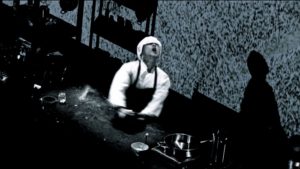Cooking is great. The smells, taste, and presentation of a dish can go a long way, working together to bring the art of cooking into day-to-day life.
A new art performance, Practices of Everyday Life: Cooking, combines two popular art styles—dancing and cooking—and is helped along by visual media prompts and large moving projections.
Composer Navid Navab says that he hopes that this performance is able to transform the boringness of everyday life into something exciting.

“As the title suggests, it’s about everyday life and what’s happening in everyday life and packing it with potential for improvisational play,” says Navab. “That means there’s a intersection where sometimes everyday life becomes playful, and then we can suddenly transform it from its mundaneness and improvise new ways of being and living.”
For Practices of Everyday Life: Cooking, Navab enlisted the help of professional dancer and chef Tony Chong, who, according to Navab, seamlessly brought together his dancing ability and his cooking skills into a show that enchants the audience.
“When we approached Tony, he said, ‘Oh, I’ve always wanted to put these disciplines together.’ What this allowed was to ask Tony to basically forget about dancing at first, and we got him to chop for hours to see where things could become playful. That’s the energy of the show. The playfulness is the craziness of the rituals; the insanities that might be in the action don’t come from the stage but from everyday action. Tony has been really great at being able to control these boundaries.”
With routine practices like cooking, it can become hard to produce a show that doesn’t seem staged or scripted. Plus, simple things like chopping, boiling, and seasoning can become robotic actions and can seem boring to some. Navab feels that Chong brings these actions to life and grabs the audience’s attention well.
“As the audience, you don’t feel like he is performing playfulness,” says Navab. “As soon as you sense someone is performing playfulness, it feels staged. At some point Tony becomes so playful that he almost becomes violent, insane, or ritualistic. Tony’s really able to go into that zone and to lose it. His sense of timing is amazing; I’ve never seen anyone that can do something so perfectly on the first attempt.”
During the performance, Chong prepares a dish that the audience can come and taste after it’s finished. As with most cooking, senses play a significant role; Navab says that one second the audience will just be sitting there and the next they’re hit with the overpowering smell of ingredients, which is all timed with the show itself.
“Tony is actually making a dish that the audience then rushes onstage to consume,” says Navab. “The multisensory aspects of the show are huge. You have this strong point in the piece where you have garlic and onion and a type of sauce that hits the audience in a strong way. They’ve been watching for about 40 minutes and then suddenly they’re hit with this strong, familiar, delicious smell. This is all timed so that the sounds and the visuals that go with it really immerse you into this environment.”
Practices of Everyday Life: Cooking
8 pm Sunday, February 26
$11, Open Space
openspace.ca
